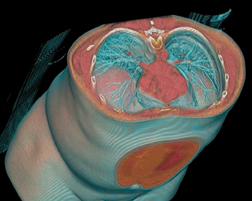
The radiation to me was negligible. Most of the high-energy photons emitted by the technetium my mother had swallowed were being absorbed. Enough registered on the detector for a diagnostic image, but a Geiger counter held next to Mom registered the equivalent of about one hundredth milliSievert (mSv). At seven feet away, I was plenty safe.
Radiation didn’t use to bother me. A decade ago I volunteered to test drive a newly developed computed tomography (CT). The docs at Erlangen University Hospital refused, showing better sense than me — and most of my fellow Americans.
As a nation, our annual exposure to medical radiation nearly doubled from 1980 to 2008, according to a report issued in March 2009 by the National Council on Radiation Protection & Measurements. CT alone accounted for 24 percent of all medical radiation exposure in the United States.
Europe probably fared better, but they too have had an appetite for CT. This modality contributes 57 percent of Europeans’ exposure to medical ionizing radiation, according to “DDM2 Project Report on European Population Dose Estimation,” a recent study of radiodiagnostic procedures in 36 European countries.
Earlier this year at its European Congress of
Radiology (ECR), the European Society of Radiology (ESR) launched an initiative designed to heighten awareness of radiation safety and promote the use of the as low as reasonably achievable (ALARA) principle. The global agendum of this initiative, EuroSafe Imaging, is to promote the safe and appropriate use of medical imaging around the world. There is reason to believe this effort will take hold.
New equipment, even entry-level CTs, deliver low single digit or sub-mSv doses for virtually any exam. Meanwhile, low kVp protocols and dose-cutting algorithms have been developed to slash patient radiation exposure by half or more on many of the installed CTs.
The sources of all ionizing radiation must be cautiously applied, not just CT. That includes nuclear medicine and radiography, and certainly fluoroscopy and cardiac cath. But CT stands out. Among the dire statistics and predictions raised at the ECR about this modality was a peer reviewed paper predicting that, in a few generations, one to two percent of all cancers in the United States will have been caused by CT exposure.
Heightened awareness is key. But more than just users must be made aware. Third-party payers must stop reimbursing the same for high- and low-dose CT exams. Ideally the use of high-dose CTs should be discontinued.
A precedent can be found in the maturation of magnetic resonance imaging (MRI), when exams done on ultra low-field MR scanners were reimbursed the same as those on high-field systems. These low performance, low image quality machines were eventually removed from radiology by accreditation standards that disallowed third-party reimbursement. Adapting this solution to CT will encourage the use of low-dose technologies and techniques by the installed base, as well as the replacement of CT dinosaurs with new low-dose scanners.
In short, while the efforts of the ESR and other groups seeking to heighten dose awareness are laudable, they will have limited effect until the owners of CT systems have an economic reason to embrace low-dose studies. It’s time for that reason to surface.


 December 10, 2025
December 10, 2025 









